Frequently Asked Questions
- Glossary of Terms for Video Production
- What is an LED?
- What is a PIXEL?
- What is a "ine pitch"?
- What is the RESOLUTION of an LED Video display?
- What is the DEFINITION of an LED Video display?
- What is the min and max distances for watching an LED screen?
- Is it possible to visualize a VIDEO on an LED Video Wall?
- What are the COLOR LEVELS?
- What is the 16 BIT TECHNOLOGY?
- What do we understand by COLOR TEMPERATURE?
- How is PURE WHITE created with THREE LEDs of different colors?
- What is the VISIBILITY ANGLE of an LED screen?
- What is the IP rate of an LED screen and what does it measure?
- What is the LED VIRTUAL PIXEL TECHNOLOGY?
- What is the LED screen REFRESH RATE and what is its importance?
- What is the LED Video Wall CONTRAST LEVEL?
- What is the LED MODULAR SYSTEM?
- What are the differences between INDOOR and OUTDOOR screens?
- Do I need permission from the City to install an LED screen in public places?
Above the Line
Generally the portion of a film's budget that covers the costs associated with major creative talent: the stars, the director, the producer(s) and the writer(s). (See also Below the Line)
Art Director
The crew member responsible for the design, look and feel of a film's set. Includes props, furniture, sets, etc. Reports to the production designer.
Assistant Director (A.D.)
Carries out the director's instructions and runs the set. The first A.D. is responsible for preparing the production schedule and script breakdown, making sure shooting stays on schedule and on budget. The second A.D. is responsible for distributing information and cast notifications, keeping track of hours worked by cast and crew, management of extras, signing actors in and out and preparing call sheets. The second A.D. is also in charge of the production assistants.
Below the Line
The portion of a production budget allotted to crew and expenses that are not classified as major creative talent.
Best Boy
Chief assistant to either the gaffer or key grip. Responsible for the daily running of the lighting or grip department.
Blocking
The physical movements and actions of actors in a given scene.
Blue (or Green) Screen
A blue or green backdrop to which computer generated images will be added to complete the background.
Boom
Overhead microphone, held on a long pole over the actors' heads.
Call Sheet
The schedule (generally issued daily) that gives each member of each department the times and places to report to set.
Camera Operator
The crew member, reporting directly to the director of photography, who physically handles and operates the camera.
CGI
Computer Generated Imagery; refers to the inclusion of computerized graphics in otherwise live-action films to enhance special effects.
Cinematography
The art of selecting devices, angles, recording media, lenses, framing and arrangement of lighting to capture moving images (see DP).
Clapboard
A small black or white board with a hinged stick on top that displays identifying information for each shot in the movie. Assists with organizing shots during editing process; the clap of the stick allows easier synchronization of sound and video within each shot.
Construction Coordinator Also known as the construction manager, this person supervises and manages the physical construction of sets and reports to the art director and production designer.
Dailies
The rough shots viewed immediately after shooting each day by the director, along with the cinematographer or editor. Used to help ensure proper coverage and the quality of the shots gathered.
Director
The person in charge of the overall cinematic vision of the film and the performance of the actors.
Director of Photography (D.P.)
In charge of the camera department and responsible for the overall look of the film from a cinematography perspective. Sets composition for each shot, selects camera, film stock, lenses, lighting and color scheme.
Dolly Grip
Prepares and operates the camera dolly, or a wheeled camera platform that moves on rails.
Double
A person who temporarily takes the lead actor's place for a stunt or to stand in for the actor in a shot when they are not available or unwilling to be shot (such as in a nude scene). Shots are done in a way to avoid seeing the double's face.
Editing
The process of arranging and selecting the shots (or parts of shots) that will be used in the final film and collating them into the order determined by the script.
Electrician
In charge of all wiring, lighting and power for the shoot.
Executive Producer
Party not invoved in technical aspects of a production but who has played a crucial creative or financial role in its development.
Extras
The people who appear in nonspecific, nonspeaking roles (part of a crowd or background) for the purpose of lending a more realistic atmosphere to a shot.
Flat
A section of a studio's set constructed of wood that simulates a wall. One side is decorated; the other is structural only.
Foley/Foley Artist
The process of adding noises or sound effects to a film in post-production in synchronization with the action on the screen.
Gaffer
Head of the electrical department, responsible for designing and implementing the lighting scheme for a production.
Greenlit or Greenlight
A commitment from a financing entity that allows a project to move from development to preproduction.
Grip
Works with both the electrical and camera departments. Trained lighting and rigging technicians who put in lighting set-ups, move set pieces and equipment around and rig camera mounts. Handle lighting equipment needed to diffuse and shape light at the direction of the D.P. The “key grip” is head of the department.
Lead Man
Assistant to the set decorator, supervising the sets crew.
Line Producer
See production manager/unit production manager.
Location Manager
Scouts and manages all filming locations. Negotiates contracts with property owners of shooting locations on behalf of the production company. Secures shooting permits and coordinates schedules with local officials. Makes sure there is proper parking for cast and crew at the locations and that locations are left in good condition after filming is completed.
Location Scout
Searches and photographs locations during preproduction based on the needs of the script. Prepares photo presentations for the director, producer or production designer. Sometimes becomes the location manager once shooting begins or works under him or her.
Producer
The person who brings the entire project together and oversees all aspects of production. In the early stages, the producer may choose a script, hire a director, help in casting and find a place to shoot the project. Once cameras are rolling, the producer makes sure the project comes in on time and on budget. May also become involved in the editing and postproduction phases, as well as marketing and distribution.
Production Assistant (P.A.)
Assigned to a department or production office to assist with general tasks.
Production Coordinator
Serves under the production manager/unit production manager (U.P.M.). Sets up and organizes the production office; coordinates travel and lodging for the crew; handles all paperwork related to insurance, daily progress reports and other matters; coordinates communication with the set and delivery of props, costumes, etc.; wraps out the production office and closes all outstanding accounts at the end of shooting.
Production Designer
Works with the director to achieve the overall look of the film from an artistic design perspective. Supervises set construction, scenery, costumes and any other item that will appear in front of the camera.
Production Manager/Unit Production Manager
In charge of the production office, this person makes business deals with local vendors and hotels, hires and fires crew, approves schedules and call sheets and keeps track of the budget.
Property Master
Responsible for acquiring, placing and maintaining any props used on set.
Rigger
Workers responsible for setting up lighting and scaffolding on film sets.
Screenwriter
The writer of the original or adapted script from which the production is shooting.
Script Supervisor
Monitors the script during shooting, making sure there are no continuity errors and that the film can later be cut together in postproduction. Keeps track of all the details of each day's shooting, including number of scenes shot and takes of each scene, what happened in the scene and any changes in the script that may impact future shooting days. Provides detailed reports to the production team and the editors.
Set Decorator
Works with the production designer on set design and decoration and oversees the dressing of the set.
Soundstage
A large soundproof area in a studio used to house elaborate sets. Allows greater control over climate, lighting and sound.
Special Effects
Also FX, SFX, SPFX. The techniques used to create illusions (such as space travel, animatronics, etc.) or to safely perform or give the appearance of performing normally dangerous acts (explosions, gunshots, etc.).
Stand-In
A person who is physically similar to an actor and takes their place during preparation and blocking of a scene. Differing from the double in that they do not appear on camera.
Steadicam
A special harness-based system that allows a cameraman to perform steady, dolly-like shots with a handheld camera, allowing for much greater freedom of movement.
Storyboard
A group of illustrations that summarize the various shots required and provide a general overview of a proposed film.
Talent
Term used to refer to all actors on a set.
Treatment
A summation of a script, longer than a synopsis, with character descriptions, scene-by-scene descriptions and sometimes limited samples of dialog.
Visual Effects
Mostly executed in postproduction, visual effects involves coordinating live action footage with CGI or other footage (animation, models) to produce a visual that would otherwise be too costly, impossible or dangerous to film.
Walk-through
First rehearsal on the set, used to figure out lighting, sound, camera positions and some rudimentary blocking.
Wrap
The term used to signify the end of shooting (either for a day or the entire production).
What is an LED?
LED (an abbreviation for light-emitting diode) is a semiconductor that emits visible light. That light is caused by the electrons flowing between the anode and cathode. The color of the visual emission depends on the used material.The LED doesn't have a filament and therefore has a longer life and a higher reliability in comparison to traditional lights.

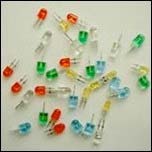
Colored LEDs
What is an LED Screen PIXEL?
A pixel (an abbreviation for picture element), is a single point in any image. A pixel is present on every LED solution. It can be composed of one or more LEDs, depending on the dimensions and characteristics of the device. In the cases of big models, the pixel is commonly composed by many LEDs.1 LED x pixel
4 LED x pixel
What is a "line pitch"?
A line pitch, sometimes called dot pitched, is the distance between two pixels in an LED display. That distance is very important, considering that a minimum difference in millimeters can make a big difference in the properties and uses of the screen. The pitch marks the minimum distance viewing, the module definition, and the resolution of the entire screen.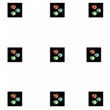
1 LED x pixel
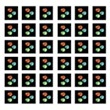
4 LED x pixel

4 LED x pixel
What is the RESOLUTION of an LED Video Wall?
The resolution of an LED display is defined by the number of pixels contained in each square meter. As we can see, the resolution is opposite proportional to the distance between pixels. For instance, if we have a lower distance between pixels, the screen will have more pixels, and therefore the resolution will be higher.
Module's Resolution
3 x 3 = 9 pixels

Module's Resolution
6 x 6 = 36 pixels
What is the DEFINITION of an LED Video Screen?
The definition of an LED screen is the number of vertical and horizontal pixels composing the whole screen. For instance, standard low definition modules are 96 x 64 pixels, common medium definition modules are 256 x 192 pixels, while frequent high definition modules are 640 x 480 pixels. As we can see, the Definition is extremely dependent on the distance between pixels. According to that idea a 96 x 64 pixels module has more distance between the pixels than a 640 x 480 pixels module, and that is the reason for the first one to have a lower definition than the second one.
Screen Definition
18 x 12 = 216 pixels
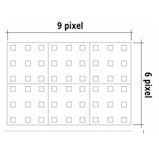
Screen Definition
9 x 6 = 54 pixels
What is the min and max distances for watching an LED screen?
The minimum and maximum visualization distances for any given LED screen are measured by two factors: the pitch and display surface.In the case of finding the minimum distance, we can get it by converting the number of millimeters of the pitch in meters. For instance, an LED screen which has a 20 mm pitch would have a minimum visualization distance of 20 m.
On the other hand, the maximum visualization distance depends on the display dimensions, and we can calculate it by multiplying for 10 times the total of square meters of any given display. In that case, a 4 x 4 meters display gives a total area of 16 m², so the maximum visualization distance is 160 m. That maximum visualization distance is for the legibility (in that distance we can see legible images). The distance of visibility is two times the legibility distance. So we can say, according to our example, that the images are legible up to 160 m, but visible until 320 m.
For the maximum distance for the text in the screen, we can say that for each cm of the letter, the text is legible until 5 m. In that case, a 10 cm letter has a legible distance of 50 m.
Is it possible to visualize a VIDEO on an LED display?
Sure it is! Now, if you want to get a high quality video visualization, the screen must have at least a 192 x 128 pixels definition.You have to remember that the Extreme Screen can work like a replicate of the monitor of your computer. Everything that appears on your monitor can visualize on the Extreme Screen.
What are the COLOR LEVELS?
Color levels are the spectrum of tones, from opaque to vivid, that any color can have. In the case of the LED visualization field, the color levels considered are the ones related to the three primary colors: Red, Green and Blue.
9 Color levels

90 color levels
What is the 16 BIT TECHNOLOGY?
The 16 bit technology is the one defined by the possibility of visualizing 512 levels of color for each one of the three primary colors used in the LED display.The ordinary 8 bit technology allows a visualization of 256 levels of colors for each primary color, for a total of 256 x 256 x 256 colors (16.8 million colors), degrading the image during the video elaboration phase. With the Extreme Screens 16 bit technology we can visualize 65,000 levels of colors for each primary color, meaning 65000 x 65000 x 65000 colors, for a total of 280 million colors. Extreme Screen's technology allows the projection of videos with high quality images, without altering the picture
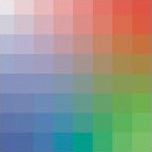
8 bit technology -- 256 color levels
16.8 million colors
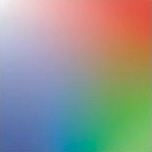
16 bit technology -- 65,000 color levels
280 million colors
What do we understand by COLOR TEMPERATURE
Color temperature is a procedure that allows the evaluation of the lights properties in any given luminous source, and its results are expressed in Kelvin degrees.If the color temperature rate is low it means that the tone of the color is nearly to red, while if the rate is high that means that the tone of the color is nearly to blue.
In the LED screens it is very important to keep the color temperature rate in a constant level, since in that way we can visualize high quality images.
The Extreme Screens have an electronic system of equalization, which compensate the color parameters with the ambient luminosity automatically. As a result of that the user obtains a constant color temperature, during day and night.
How is PURE WHITE created with THREE LEDs of different colors?
The reason for that is that the human eye has three types of receptors, and each receptor corresponds to a primary color. The rest of the colors are a mix of the primary ones and we can see them thanks to the simultaneous stimulation of our three receptors. In that case, the white color is also a mix of the three primary colors (50% of green, 30% of red and 20% of blue).The Extreme Screens can get a total of 280 million colors, which guarantees a high quality in image and visualization.

8 bit technology -- 256 color levels
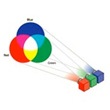
8 bit technology -- 256 color levels
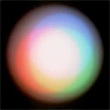
8 bit technology -- 256 color levels
What is the VISIBILITY ANGLE of an LED screen?
The visibility angle of an LED screen is the angle where the luminosity of the display is higher than 50% of the frontal luminosity. Each LED screen has a different visibility angle. For example, for any screen with a 120° visibility angle, it means that in a frontal view it has 6000 NIT luminosity, and on the limit of the 120° visibility angle view has 3000 NIT luminosity.
What is the IP rate and what does it measure?
IP (abbreviation for Ingress Protection) is the protection rate against the humidity and dust. The IP rate has two numbers. The first one refers to the protection grade against the dust, and the second one to the protection grade against the water. When those numbers are higher, it means that the electronic device is more protected and therefore keeps its internal components safe and clean. The Extreme Screens have an IP65 protection grade, the highest IP rate in the visualization LED field.What is the VIRTUAL PIXEL TECHNOLOGY on an LED Video Wall?
It is a technology that allows image visualization with higher definition than the physics definition of any display. The virtual pixel technology is able to control each LED. That means that each pixel can superpose the next one, and make the "virtual pixel" (a pixel which is only perceptive to the human eye).As we know, the higher the definition, the better the image visualization. For that reason, the Extreme Screen, due its virtual pixel technology, can visualize images with four times higher definition than the physical definition of other displays and therefore the images are detailed and real.

Physical Definition Without Virtual Pixel Technology


Virtual Definition With Virtual Pixel Technology

What is the LED screen REFRESH RATE and what is its importance?
The refresh rate is the number of times that the images are refreshed every second. It is an important factor because the images quality depends on the refresh rate quality. For instance, if the refresh rate it is too low it can cause headache and eye damage.A normal TV has a refresh rate of 60 Hz; the last generation TVs has a refresh rate of 120 Hz at top. The Extreme Screens have a refresh rate of 240 Hz, more than two times the last generation TVs refresh rate. That is another demonstration about the quality of the Extreme Screen.
What is the CONTRAST LEVEL?
The contrast level is the difference between the light which is emitted by the screen and the ambient light that is reflected by the display. When the reflected light is lower, the contrast level is higher and it makes the images more clear. The Extreme Screens have anti-reflex flyers which split the ambient light so the contrast level increases and the images get a much better view, even with direct sun light exposition.What is the LED MODULAR SYSTEM?
It is the system that allows you to build any screen you want. To say it in another way, the modular system permits building a screen in any dimension, assembling the right number of modules. The Extreme Screen modules have a lot of dimensions and perfect pixel alignment in horizontal and vertical positions, guaranteeing that the screen will be in perfect conditions after it has been assembled. Also the modular system offers advantages such as easy transportation, easy maintenance, and no size and shape restrictions.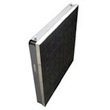
Base Module
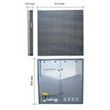
975 x 977 x 125 mm

Modular System
What are the differences between INDOOR and OUTDOOR LED screens?
1) The outdoor screens have a lower resolution because the people watching the images on the screen are located at a longer distance; therefore, they don't really need a high resolution, as it is the case for indoor screens.2) Because of the typical characteristics of the places where they are installed, the outdoor screens have special protection against dust, water, salty air, corrosive elements, and tough weather. On the other hand, outdoor screens have special ventilation systems which keep the inside temperature constant and doesn't let it pass the critical levels.
3) The outdoor screens have a double function protection system, protecting the screen against the sun (increasing the contrast levels and obtaining a better image) and against vandalism acts.
4) The outdoor screen requires high brightness because the people watching the screen are placed in a larger distance, and it is necessary to have brighter images for a better visualization.
Do I need permission from the City to install an LED screen in a public place?
Yes. If you want to install an LED screen in a public place, it is necessary to get a council's permission. There are no standard regulations about this, so the user must obtain this information directly from the City Hall where the screen will be placed.